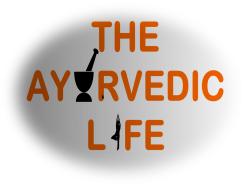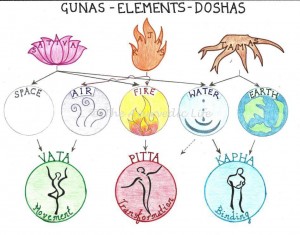Ayurveda is an ancient healing science that originated in India and is more than 5000 years old. “Ayur” means life, “veda” means science or knowledge. So, Ayurveda literally means a science that helps us to live life to the fullest potential. Ayurveda is part of the ancient Indian Vedic wisdom and is part of the Atharvaveda.
It focuses equally on prevention of disease as it does on treatment of disease. Prevention of disease and maintenance of optimum health can be made possible by following appropriate diet, sleep and lifestyle principles. The underlying commonality between all these principles is to be as much in harmony with nature as is possible. This aspect of “prevention” rather than “treatment” alone, makes it a unique science whose relevance in our current stress-ridden societies is pertinent and compelling.
Treatment of disease is focused on addressing the root cause of the disease, rather than the symptom alone. In some cases, symptoms are also treated, but the focus is always on eradicating the root cause, so that recurrence is prevented.
5 Universal Elements (Panchamahabhutas)
According to Ayurveda, everything in the universe is made up of some combination of 5 basic elements. Not just material objects that surround us, but also our own bodies, thoughts, feelings, everything is made up of a combination of the panchamahabhutas.
- Ether/Space: Space that surrounds us, spaces within our body, spaced out feelings – all constitute the ether/space element.
- Air: Breeze, wind in our bodies, our racing mind – all constitute the air element.
- Fire: Fire that cooks our food on the stove, our digestive fires that cook our foods once ingested into the body, fiery emotions – all constitute the fire element.
- Water: Water in the oceans, rain, liquids inside our body like blood, saliva, gastric juices, cool, flowing thoughts – all constitute the water element.
- Earth: Mountains, trees that surround us, our internal organs and bones, strong, grounding emotions – all constitute the earth element.
Mind-body Principles or Energies (Doshas)
The panchamahabhutas combine to form 3 distinct patterns or mind-body energies.
- Vata (Ether + Air)
- Pitta (Fire + Water)
- Kapha (Water + Earth)
Our bodies have a unique combination of the 5 elements. This gives rise to our own unique mind-body disposition or energy. These energies are called doshas. They determine our physical appearance and also our way of thinking and behaving. It is in our best interest to maintain this combination of energies throughout our lifetime, because an imbalance (excess or scarcity) of doshas that deviate us from our inherent “balance” will be the start of disease.
Vata is the principle of movement and change. Pitta is the principle of transformation, digestion, metabolism. Kapha is the principle of structure, binding. All of us have some presence of all the 3 doshas within us, but due to the dominance of 1 (or most likely 2 and sometimes all 3) doshas), distinctive individual qualities of the body and mind arise. This combination of doshas in us makes up our own unique, individualistic constitution or prakriti. This is decided at conception time itself and will not change throughout our lifetime. Incorrect diet and lifestyle patterns may cause a deviance from this basic energy distribution that is inherently our nature, potentially leading to a doshic imbalance (vikriti), which if not corrected in a timely manner may ultimately lead to disease. Click here if you need to know what your constitution is.
Vata
Vata symbolizes movement and change. Muscle movement, nerve impulses, thoughts are all governed by the vata principle.
People with this predominant dosha tend to be light and lean. They tend to be energetic, creative and lively. They walk, talk and think fast, but tire easily. They grasp concepts quickly, but also forget easily. They have variable appetites and digestion.
When vata is out of balance, symptoms like racing thoughts, anxiety, fear, irregular digestion, dryness, gas and constipation arise.
Excess exercise, irregular schedules, dry and cold environs and foods, frequent travel, constant stimulation, loud noises are factors that can derange vata.
Regular schedules for food, sleep, exercise and other activities is key to keeping vata in balance. Oil massages, steam baths, eating warm, cooked, moist, grounding foods, regular meditation and other relaxation techniques, rest are all key ways to keep vata under control.
Pitta
Pitta symbolizes transformation, heat, digestion and metabolism.
People with this predominant dosha tend to be of medium build, with bright, sharp eyes and a warm, ruddy skin. They tend to early graying and early loss of hair. They tend to be sharp, intelligent, purposeful people with good powers of comprehension. They are natural leaders. They have strong appetites and thirst.
When pitta is out of balance, the person becomes short tempered, easily agitated, judgmental, critical and over ambitious. They tend towards qualities like jealousy, envy, anger and hate.
Intense heat, intense exercise, intense emotions, spicy, salty, oily foods, excessive alcohol intake, dehydration are all factors that can derange pitta.
Cooler environs, exercise of medium intensity during the cooler part of the day, cooling, mild foods, adequate water intake, calming thoughts and relaxation practices, meditation, going to bed early (by 10pm), avoiding alcohol, a less intense perspective to life in general and doing less, not more 🙂 will all help keep pitta in balance.
Kapha
Kapha symbolizes structure, binding and fluidity.
People with this predominant dosha tend to be heavier, with well-developed musculature, large, attractive eyes and thick, lustrous hair. They tend to be reliable, contented, calm, kind, loving and forgiving people. While they may tend to be slower to grasp things, they have excellent long-term memories. They are grounded, stable people who tend to earn and hold on to money.
When kapha is out of balance, weight gain, fluid retention, allergies manifest in the body. In the mind, excess kapha manifests as stubbornness, over attachment to people, jobs and things, even though these may no longer be nourishing or necessary. The person with excess kapha may tend to be lethargic, slow, lazy, bored and excessively tired.
Lack of exercise, sedentary jobs, excessive food intake especially of sweets, oily and heavy foods, excessive sleep are factors that can aggravate kapha.
Adequate exercise, avoiding excessive and untimely sleep habits, adopting an active lifestyle, avoiding heavy, oily, sweet, cold foods and choosing lighter, dryer foods will all help keep kapha in balance.
Qualities/Properties/Attributes (Tattvas)
In Ayurveda, everything in our physical and mental world (foods, thoughts, seasons, body etc.) is experienced as a combination of 20 qualities. There are 10 pairs of opposing qualities. They are:
- Cold/Hot
- Dry/Moist or Oily
- Static/Mobile
- Rough/Smooth
- Dense or Solid/Liquidy
- Heavy/Light
- Hard/Soft
- Dull/Sharp
- Gross/Subtle
- Cloudy/Clear
Each of the doshas have particular attributes:
Vata: Dry, light, cold, rough, subtle, mobile, clear
Pitta: Oily, sharp, hot, light, liquid, mobile
Kapha: Heavy, static, cold, oily, smooth, dense, soft, cloudy, gross.
Since our individual constitutions are nothing but a combination of doshas, it follows that our bodies are a unique combination of attributes also. To maintain good health, we need to maintain a balance of these attributes within us. As far as attributes (and common sense :)) go, like increases like. This means that if you add more heat to an already heated system, it becomes more heated. So, to maintain balance, we need to use opposite attributes. For a fiery pitta constitution, during a hot summer, cooling attributes (from food, lifestyle, thoughts etc.) will have a favorable effect of cooling the person down.
Mental Qualities (Gunas)
These are attributes of the mind and can be gauged by how one is feeling. These qualities show the capacity of the mind to perceive truth and act accordingly. One can say that these qualities reflect the level of development of the soul.
1. Sattva
Sattva is clarity.It brings about internalization of the mind, movement of the consciousness inward and unification of the head and heart. The mind that is still, calm, pure, focused but not feverish and harmonious is sattvic. Sattvic people tend to be harmonious and adaptable in nature. They are considerate of others, take care of themselves and their bodies, strive towards balance and enjoy a general peace of mind that keeps them healthy and happy. They tend to see the good in everything and look at life as a learning experience. Sattva can be improved by spiritual cultivation, yoga, meditation, chanting, mantra, sattvic diet and lifestyle, spending time in nature and living life in harmony with one’s constitution.
2. Rajas
Rajas is distraction or turbulence of the mind.It causes us to look outward and lose ourselves in the external world. Desire, disturbed thoughts, anger, ego, greed, envy are all rajas. The mind that is seeking stimulation is rajasic in nature. Rajasic people have good (sometimes excessive) energy and have a tendency to burn themselves out with excessive activity. They are often impatient and inconsistent in their general approach to life and tend to blame others for their problems.
3. Tamas
Tamas is heaviness, lethargy, dullness. It causes the mind to be clouded by fear and ignorance and results in an inability to perceive.The mind that is unfocused, inattentive, dull and dominated by subconscious forces, is tamasic in nature. Tamasic people tend to have blocked or stagnant energy and emotions. They are often caught in bad habits, addictions and attachments that they are unable to question.


Dear Anu,
I have been following a few things that is mentioned in your website for a while now and what a great positive changes it has brought to our lives. I always used to wonder about – how do I know all the good stuff that is out there whether it is good for my family’s well being and if it suits us. From your website I not only got the answer to my question, but also it showed me how to make the not so suitable stuff suitable. I feel so empowered now that I know everything is within my reach. Your website is truly a gift to me and all those who strive to achieve good health both physiological and psychological. A big Thank You to you from the bottom of my heart!!
Cheers,
Archana
Dear Archana,
Thank you so much for your heartfelt message. My biggest reward for this website is readers and friends like you who benefit from its contents. A big thank you to you as well!
Anu